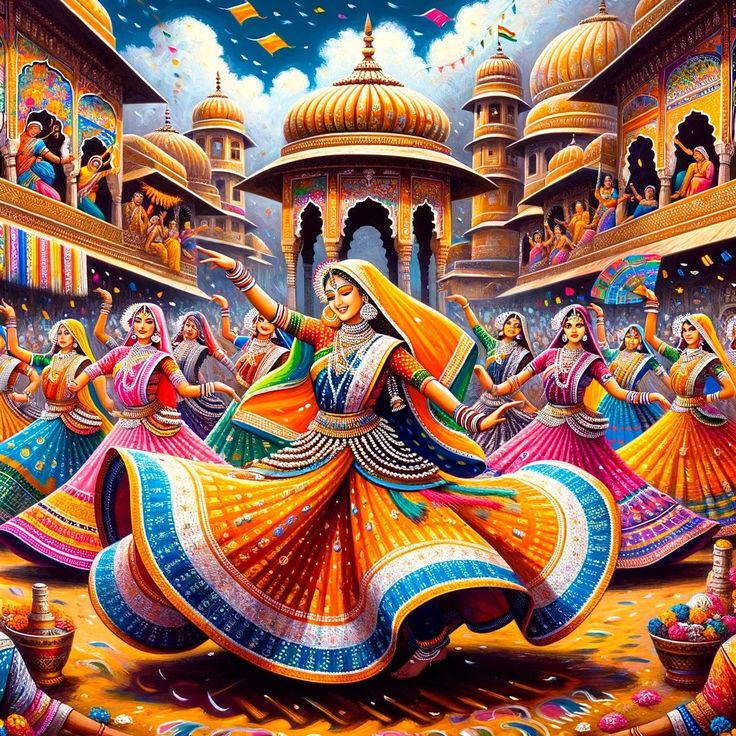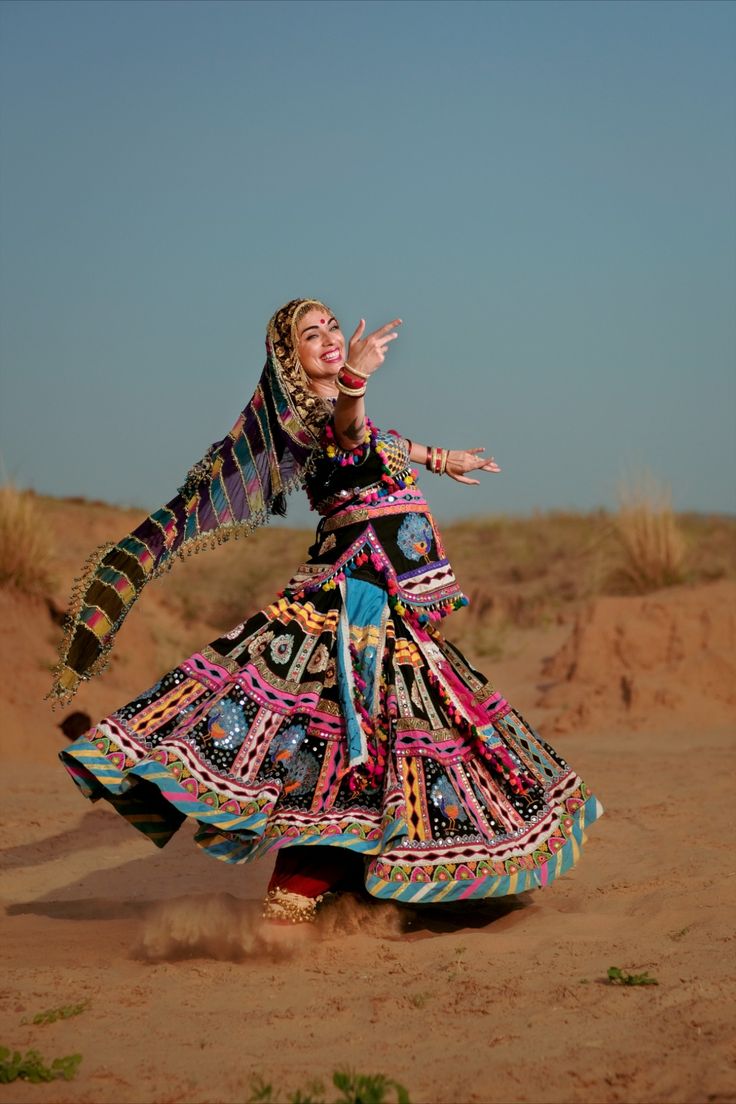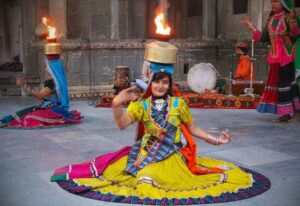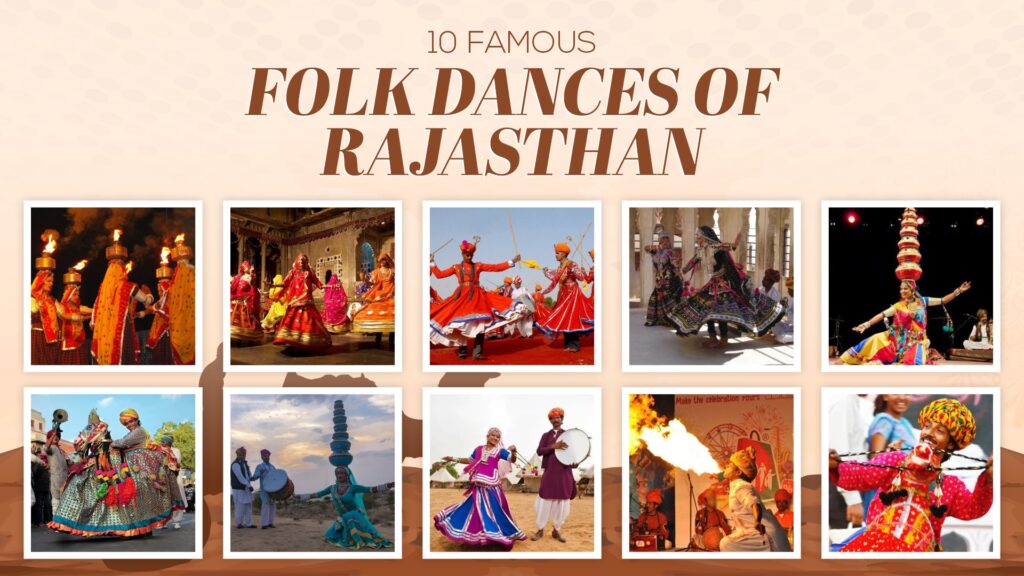Rajasthan, the land of majestic forts, colorful festivals, and rich history, boasts a vibrant cultural heritage that extends far beyond its architectural wonders. At the heart of this heritage lies the captivating world of Rajasthan folk dance. These traditional dance forms, passed down through generations, are not just mere entertainment; they are stories etched in movement, reflecting the region’s social fabric, traditions, and deep-rooted beliefs.
Get ready to be mesmerized as we unveil 10 of the most popular dance forms that Rajasthan has to offer:
1.Ghoomar: A Twirling Celebration of Joy

Source – Pinterest
Imagine a kaleidoscope of colors swirling to the rhythm of soulful music. That is the essence of Ghoomar, a famous dance of Rajasthan performed exclusively by women. Adorned in vibrant ghagras (long skirts), the dancers twirl gracefully in circles, their movements reflecting a joyous spirit. Traditionally performed during festivals like Teej and Gangaur, Ghoomar is a celebration of womanhood, love, and the monsoons.
2.Kalbelia: The Dance of the Snake Charmers

Source – Pinterest
Weaving a magical spell with their captivating moves, the Kalbelia dance is a true spectacle. Performed by the Kalbelia tribe, also known as the Sapera community, this Rajasthan folk dance is named after “Kal,” meaning snake. The dancers, primarily women, mimic the serpentine grace of a snake through their swaying movements and hypnotic hand gestures. Interestingly, Kalbelia was recognized by UNESCO as an Intangible Cultural Heritage of Humanity in 2010, solidifying its unique place in Indian culture.
3.Bhavai: A Balancing Act of Artistry and Grace
Prepare to be awestruck by the artistry and elegance of Bhavai, a traditional dance of Rajasthan. This vibrant dance form showcases the remarkable skill of balancing earthen pots on the head while performing intricate steps. Traditionally performed by women from various communities like Jats, Bhils, and Raigars, Bhavai narrates stories through vibrant costumes, lively music, and captivating expressions. The dance is a testament to the strength and grace of Rajasthani women.
4.Chari: Celebrating the Joy of Water

Source – Pinterest
Water, a life-sustaining resource, holds immense significance in Rajasthan’s arid landscape. The Chari dance beautifully reflects this reverence. Performed by women, especially from the Saini and Gujjar communities, Chari celebrates the act of collecting water. The dancers, dressed in their traditional best, gracefully balance brass pots (Chari) on their heads while moving to the rhythm of dhol beats and soulful songs. The dance is a visual representation of the joy associated with this vital element.
5.Gair Ghumna: A Spirited Group Performance
If you enjoy energetic group performances, then Gair Ghumna is a must-see Rajasthan folk dance. Traditionally performed by the Bhil community during vibrant festivals like Holi and Janmashtami, this dance involves both men and women. Dressed in colorful attire, the dancers move in circles, forming intricate patterns with their steps. They often carry sticks called ‘khanda’ or even arrows and swords, adding a touch of martial spirit to the dance. The lively music and synchronized movements create a truly captivating spectacle.
6.Kathputli: The Magic of Storytelling Through Puppets
While not a dance performed by humans, Kathputli holds a special place in the realm of Rajasthan folk dance. This unique art form involves the manipulation of wooden dolls (Kathputli) by skilled puppeteers, usually belonging to the Bhat community. The puppeteers bring these dolls to life, enacting stories from mythology, Indian folklore, and even contemporary social issues. The rhythmic music and the vibrant puppets create a mesmerizing experience for audiences of all ages.
7.Kachhi Ghodi: A Tribute to Horse Riders
Get ready to be transported to the battlefields of Rajasthan with the thrilling Kachhi Ghodi dance. This energetic dance form depicts the valor and skill of Rajput horse riders. Men dressed as riders perform breathtaking acrobatic feats while balancing on hobby horses. The lively music and the dancers’ daring moves recreate the essence of horseback warfare, leaving audiences awestruck.
8.Terah Taali: A Test of Skill and Coordination
If you appreciate displays of physical prowess, then Terah Taali is a Rajasthan popular dance you shouldn’t miss. Primarily performed by men in the Marwar region, this dance is known for its demanding nature. The name “Terah Taali” translates to “thirteen claps,” signifying the crucial role of rhythmic clapping incorporated into the dance. The steps require immense skill and coordination, making Terah Taali a true test of the
9.Bhatiyari: Narrating Tales Through Melodious Songs
Journey back in time to Rajasthan’s royal courts with the Bhatiyari dance. Traditionally performed by women in the Marwar region, this famous dance of Rajasthan was originally presented by the Bhat community. These hereditary bards used the Bhatiyari dance to narrate historical ballads and chronicles of Rajput kings. The dancers, adorned in elegant costumes, move gracefully to the rhythm of soulful songs, often accompanied by instruments like the dhol and the pungi. Their captivating expressions and storytelling prowess bring the tales to life, offering a glimpse into Rajasthan’s glorious past.
10.Sufi Dance: A Whirling Expression of Devotion
Transcend the physical realm and delve into the depths of spiritualism with the Sufi dance. This unique traditional dance of Rajasthan revolves around the concept of Sufism, a mystical branch of Islam that emphasizes love, devotion, and union with the divine. Performed by men called Qawwals, Sufi dancers wear long, flowing skirts and twirl gracefully to the hypnotic melodies of Sufi music. The rhythmic chanting and the dancers’ mesmerizing movements create a trance-like atmosphere, allowing participants to connect with their inner spirituality.
The Soul of Rajasthan Folk Dance
Rajasthan folk dances are more than just entertainment; they are a window into the soul of Rajasthan. Each dance form tells a story, reflects the region’s social fabric, and embodies the rich traditions passed down through generations. Whether it is the celebratory spirit of Ghoomar, the captivating movements of Kalbelia, or the storytelling magic of Kathputli, these dances offer a vibrant tapestry of Rajasthani culture.
Witnessing a Rajasthan folk dance performance is a truly unforgettable experience. The colorful costumes, the pulsating music, and the dancers’ energetic movements combine to create a spectacle that leaves a lasting impression. So, on your next visit to Rajasthan, don’t miss the opportunity to immerse yourself in this vibrant cultural expression. You might even find yourself swaying to the rhythm, captivated by the magic of Rajasthan folk dance.
Frequently Asked Questions
1.What is the famous folk dance of Rajasthan?
Rajasthan boasts several renowned folk dances, but Ghoomar stands out for its graceful twirling movements and vibrant energy. Performed by women, it is a popular sight during festivals like Teej and Gangaur.
2.Which Rajasthan folk dance is included on the UNESCO list?
The mesmerizing Kalbelia dance, also known as the “Snake Charmer Dance,” has earned a coveted spot on UNESCO’s Intangible Cultural Heritage list. Its captivating movements mimic the serpentine grace of a snake.
3.What is the folk dance where dancers balance pots on their heads in Rajasthan?
Bhavai is a stunning dance showcasing skill and artistry. Traditionally performed by women from various communities, Bhavai involves dancers balancing earthen pots on their heads while executing graceful steps.
4.Is there a fire dance in Rajasthan?
While not involving actual fire, Rajasthan folk dances often exude fiery energy and passion. Dances like Ghoomar and Terah Taali showcase energetic movements and pulsating rhythms that can ignite a sense of excitement in the audience.

